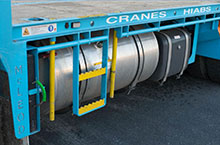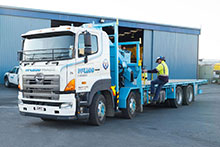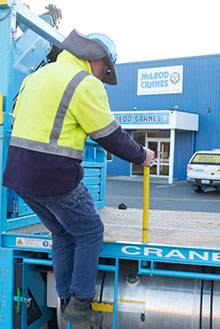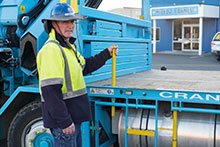McLeod Hiabs
Congratulations to the Team at McLeod Hiabs for taking out the Safety Innovation Award – Large Business at the 2015 Site Safe Health and Safety in Construction Awards.
Introduction
In 2013 Mcleod Hiabs Ltd was founded by Scott and Peter McLeod and Phil Hutchinson, through the purchase of a small hiab transport company operating out of the Bay of Plenty. Through its highly skilled and experienced team and ongoing innovative thinking, McLeod Hiabs Ltd has grown its operations to transport palletized products and trusses using Hiab, Crane or Forklifts throughout the rest of the North Island.
We spoke to the company’s Managing Director, Scott McLeod, on how McLeod Hiabs successful initiative of installing ladders on Hiab Trucks (Hiabs) have improved the health and safety of their team of operators, and also allowed them to win the Safety Innovation Award at the 2015 Construction Health and Safety Awards.
Situation
When the business was originally purchased there was very little in the way of a Health and Safety Policy and a lot of work needed to be done in order to bring the quality of health and safety throughout the business up to scratch. Through the process of building a strong health and safety culture and laying the foundation of effective operating procedures, a policy was developed to ensure three points of physical contact whilst accessing mechanical equipment including vehicles. To ensure employees were reminded of this policy a sticker was placed on the relative equipment promoting three points of contact, including on all Hiabs.
Whilst most work with Hiabs was encouraged from the ground, in some circumstances there was a need to climb up onto the deck of the Hiabs in order to load/unload material. It was later found that it was impossible for employees to maintain three points of contact whilst accessing the deck of the Hiabs. Often employees were jumping off the decks to get back down, which was resulting in some sprained ankles and minor falls. After some research into the issue the team found that “jumping down from the deck exerts 12 times their body weight on their ankles, knees, hips and lower back. For the average driver that is equal to a tonne of shock”.
Whilst work boots were provided to help avoid sprains, it was obvious there was a need to eliminate the jump completely.
What did they do?
After reviewing the Hazard Register and Incident Reports it was apparent that this had been a problem due to a record of sprains and minor falls in the past, mainly from operators needing to jump off the decks to get down. McLeods engaged its Health and Safety committee including members from McLeod Cranes, to help find a solution. After some discussion it was clear it was necessary to revisit the design of the Hiabs to eliminate the need to jump off the deck. This is when McLeod Hiabs engaged their manufacturing partner, Waimea Truck and Cranes Limited.
McLeod Hiabs took to the market for research and evaluation, and after reviewing a number of prototypes presented by Waimea Truck and Cranes Limited, the design of a manual ladder was agreed as the most effective method of accessing the deck. The ladder lifts up from the side of the deck, and locks firmly into place. This allows the hiab operator to access and dismount the deck safely using three points of contact. Once dismounted, the ladder poles lift and twist to unlock, and the ladder slides down into its storage space.
This would mean quick and easy access to the deck using three points of contact, with the ability to fold the ladder away. This would also eliminate the need to jump down from the deck which would reduce the risk of injury.
Results
Whilst there are still a few injuries being reported on the Incident Register from other vehicles, there have been no injuries reported from hiab operators using the Hiabs with ladders installed. Scott noticed “we are finding that because the ladders are easy to use, they are the preferred choice of access for our operators. Many operators are even leaving the ladders up and only put them away when they need the extra deck space. This means the ladders are being used well – resulting in no further injuries”.
The process that was used and the apparent results have built a strong foundation of innovation and health and safety appreciation across the company. Change is more accepted than it once was, and a particular mindset of “review and improve” has really been engrained into everything McLeod Hiabs does.
Outcomes and benefits
When it comes to manufacturing hiabs, there has been a real positive shift in the way of thinking. The priority is now on the operator, and the hiab is built to ensure operator safety. Scott said “Access is now the main priority which means all other parts of the hiab including tanks, hydraulics and batteries are planned around the access point”.
There are now 5 vehicles with ladders installed, and McLeod Hiabs is now looking to install ladders across other types of machinery too.
Managing Director Scott McLeod is proud of what the team at McLeod Hiabs have achieved. “We would love to see more people doing the same thing with their trucks. We don’t see it as proprietary. It’s a great idea and something simple you can do which can make a huge difference. It’s simple – and that’s why it works.”
This particular focus on access, taking the Hiab Operators health and safety into account as a priority, has really built a strong culture of willingness to change for the better. The team feel they have been heard and are more motivated to look for new innovations through other areas of the business. It’s been a threefold win across all areas of the business, health and safety, employee satisfaction and productivity, and strategic innovation.
For more information on our awards visit our Health and Safety Awards page.
We’re very grateful that Site Safe has an award for health and safety in the construction industry. It also gives us a tool to stimulate innovate thought from our committee.
 |
|
 |
|
 |
|
 |
|

